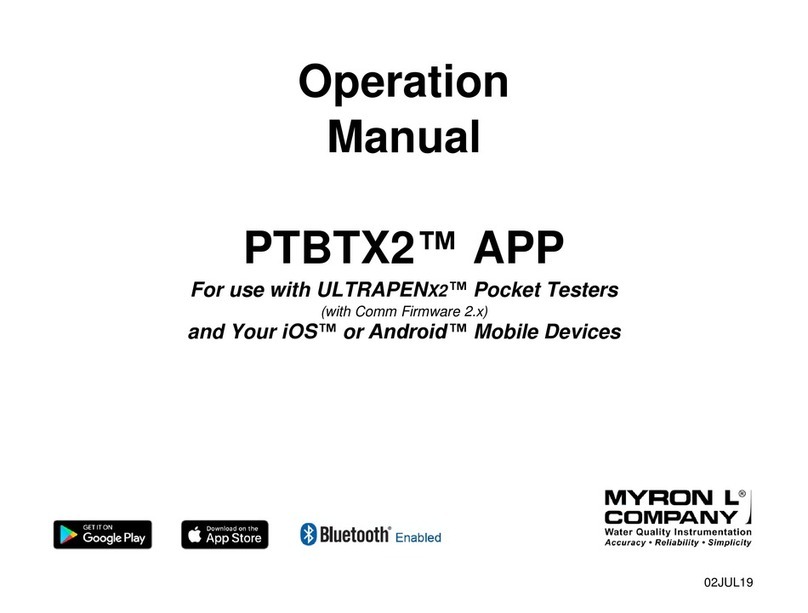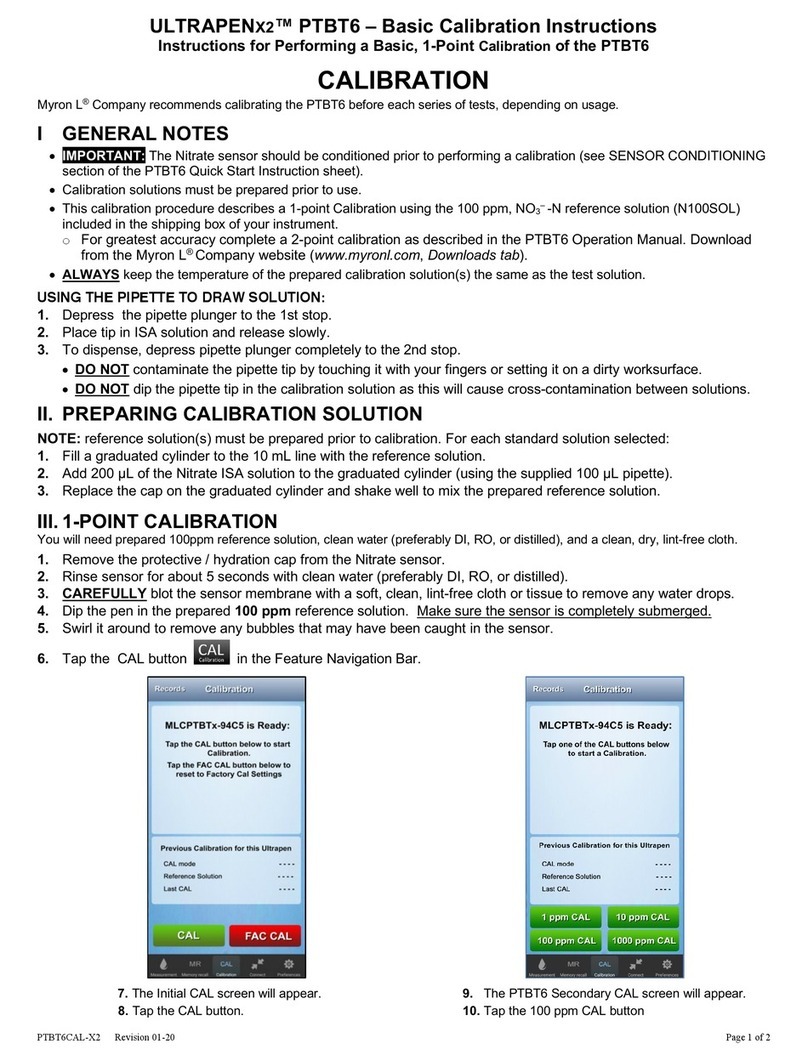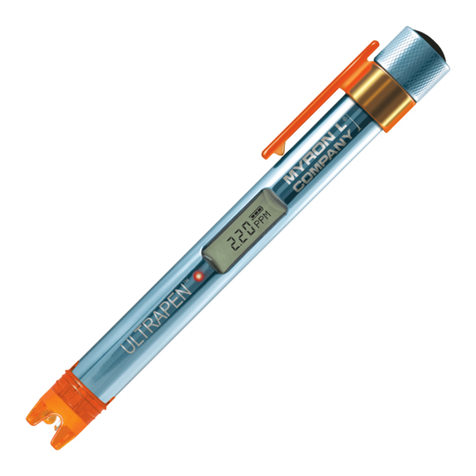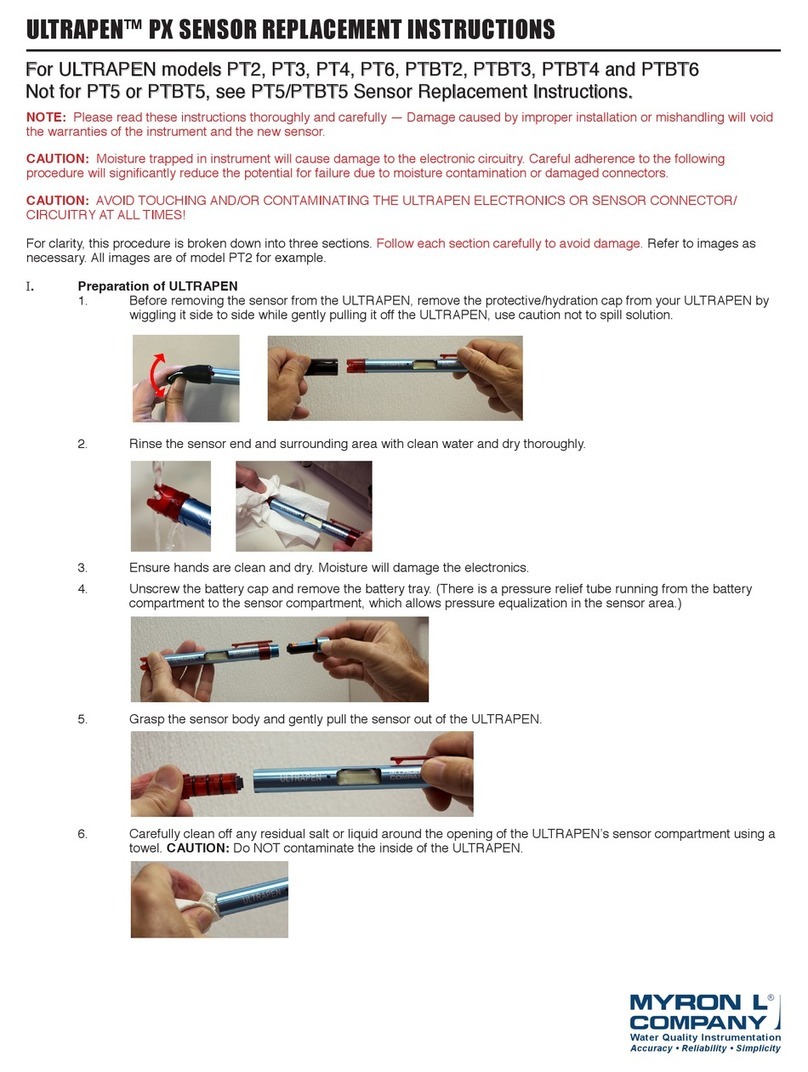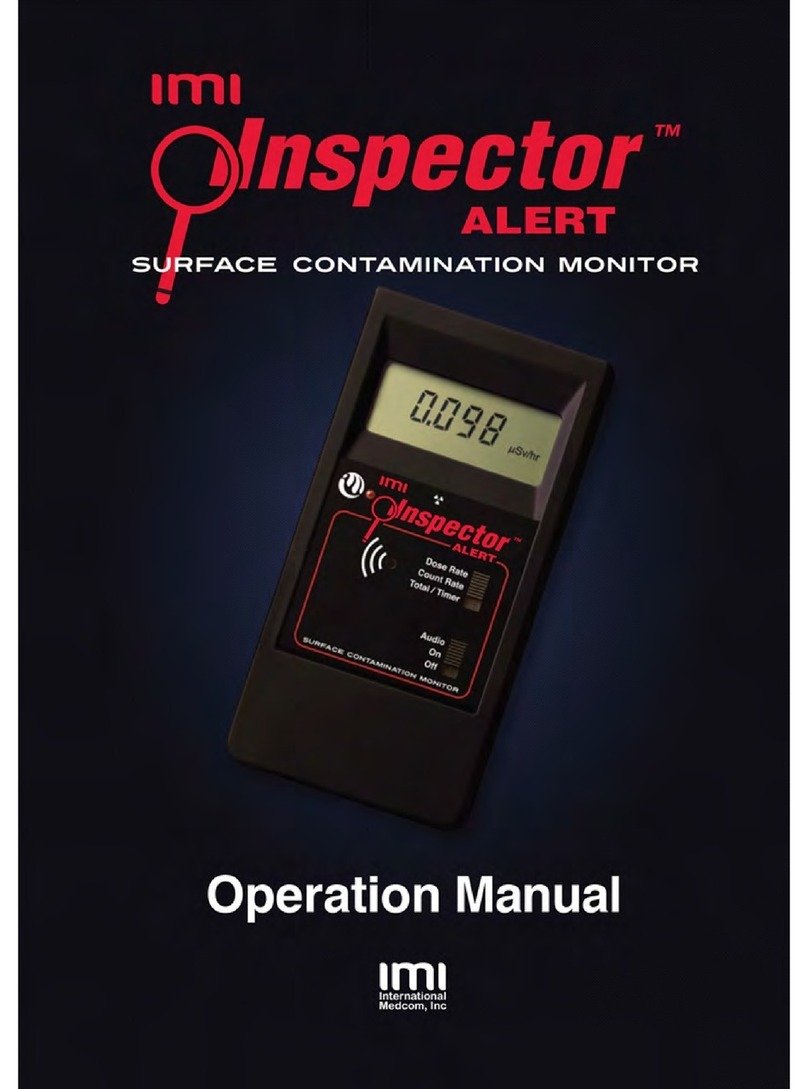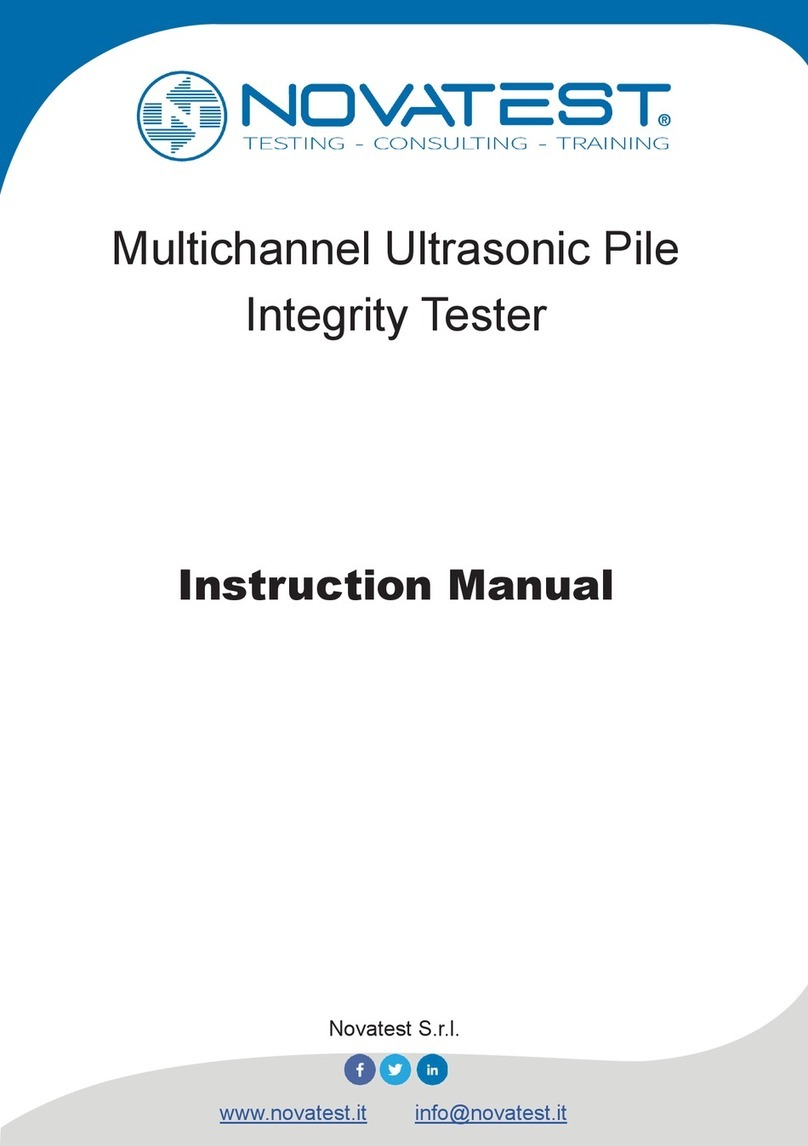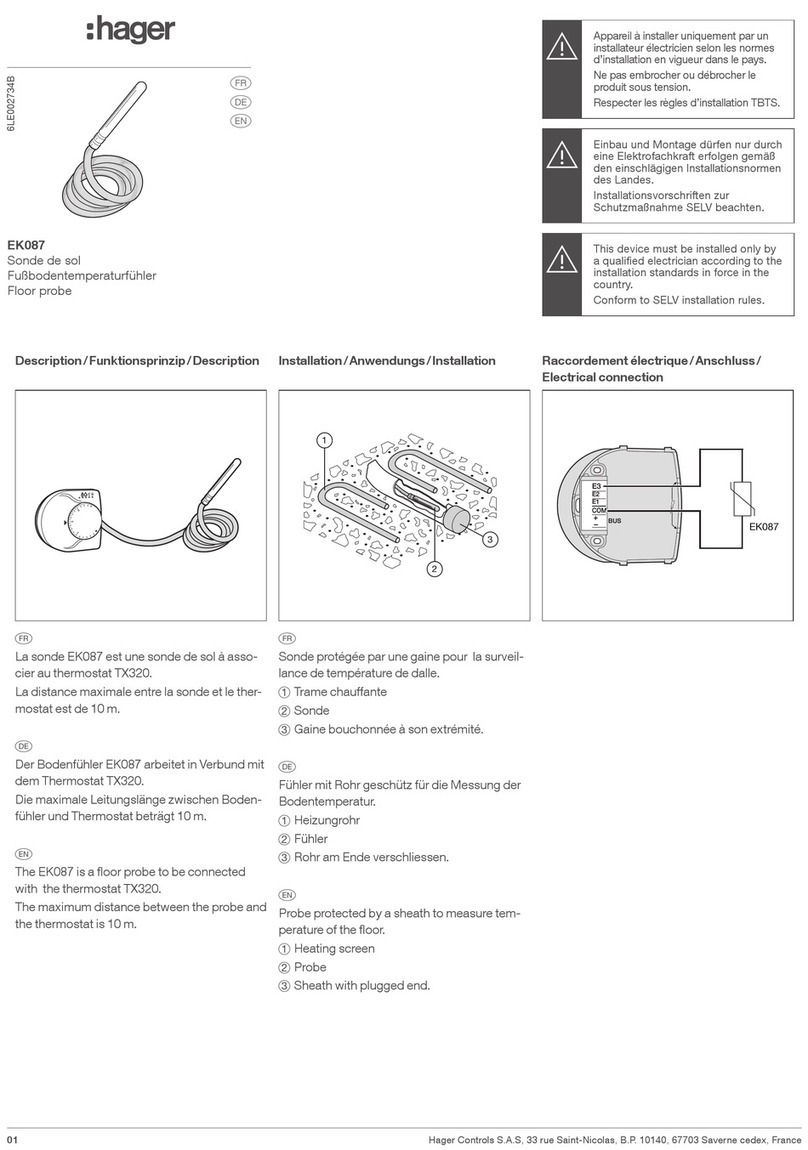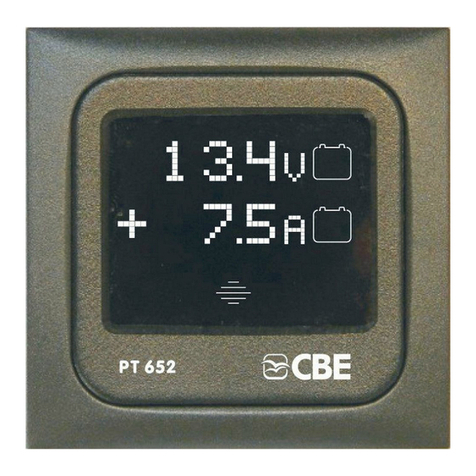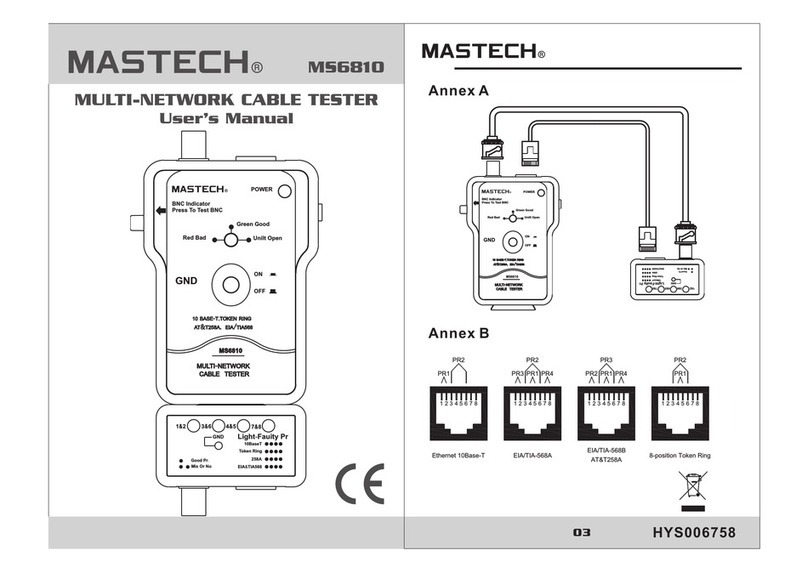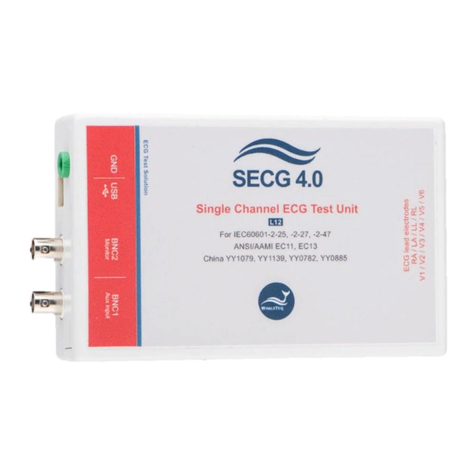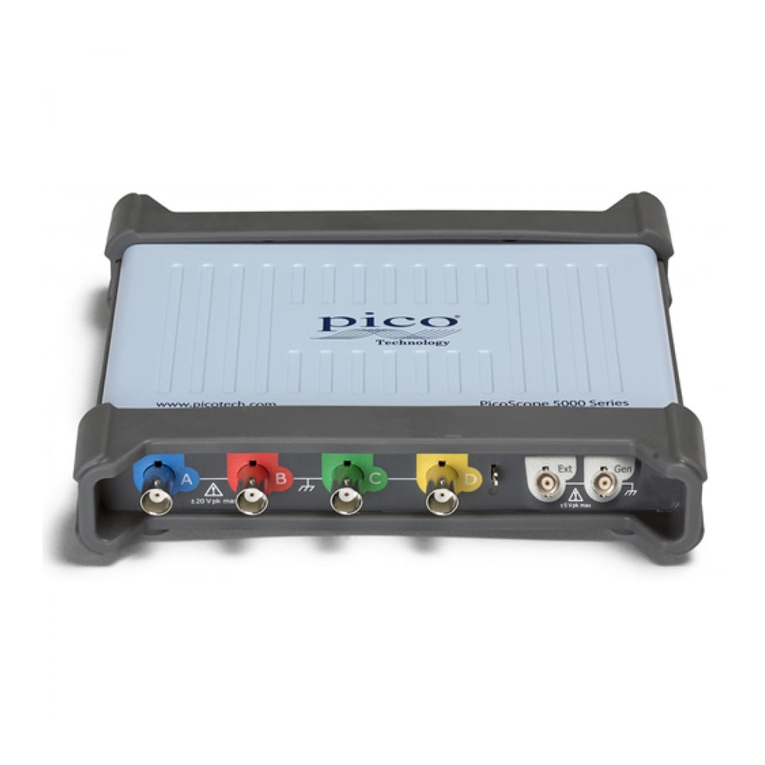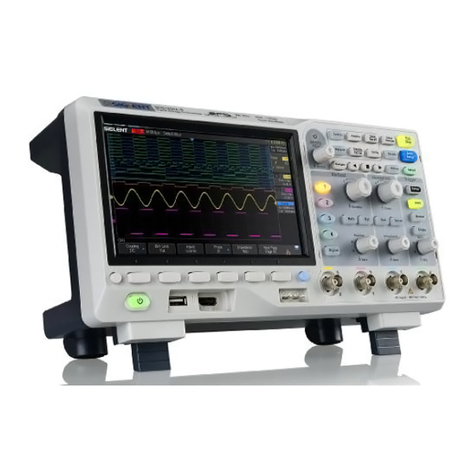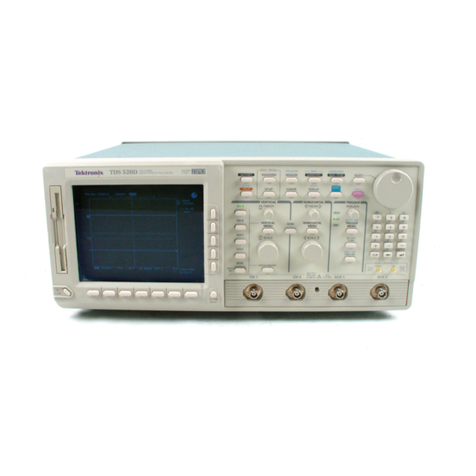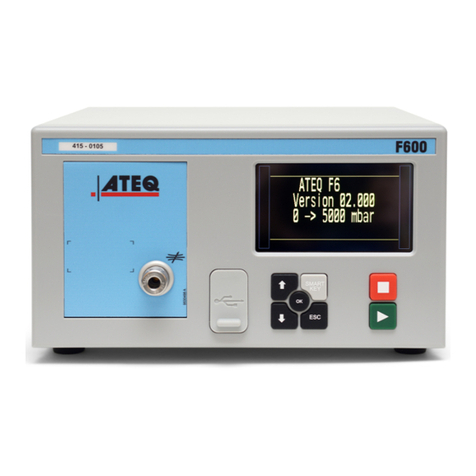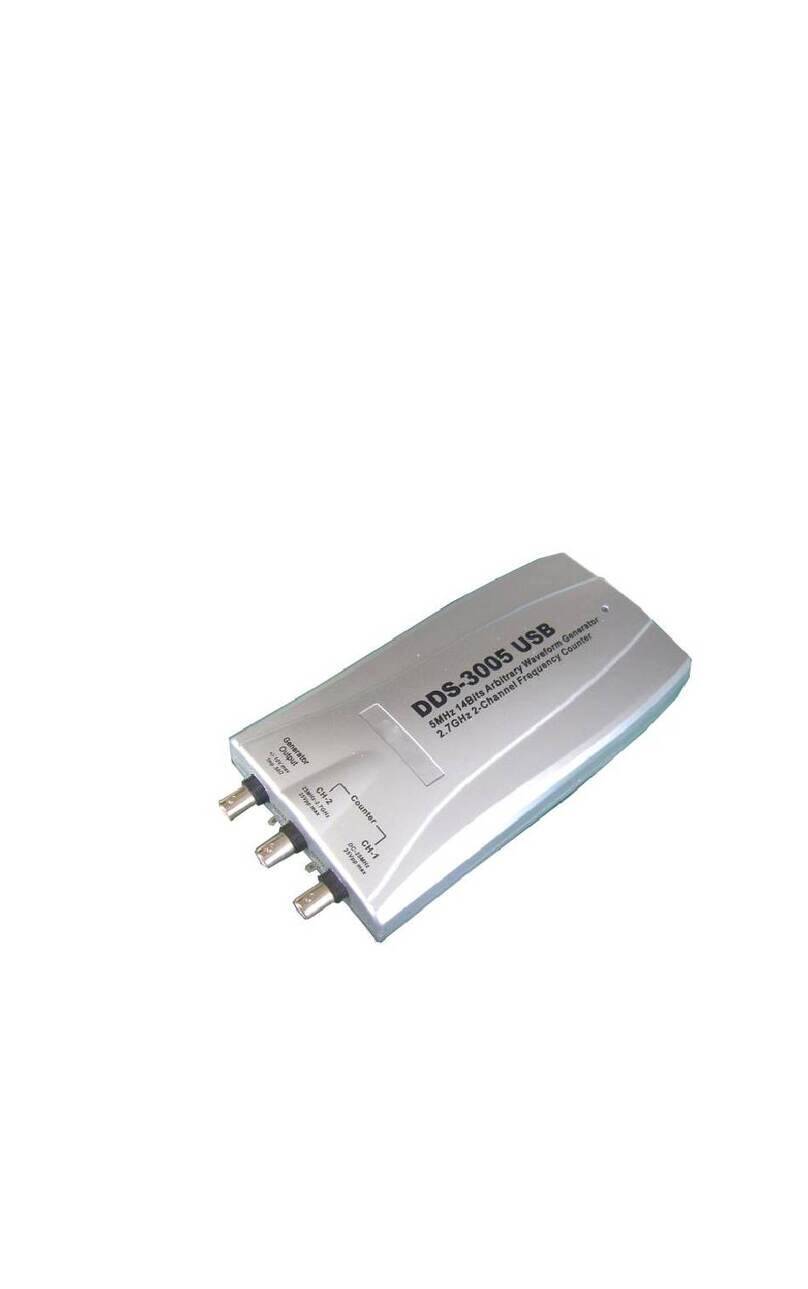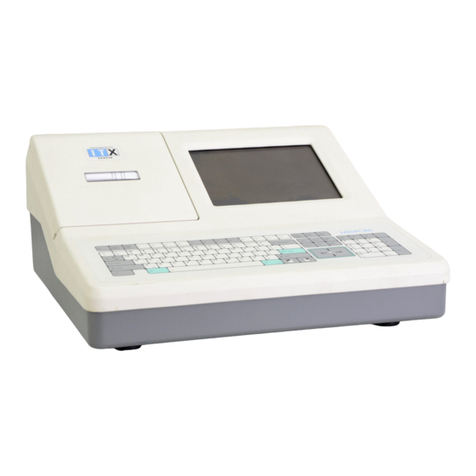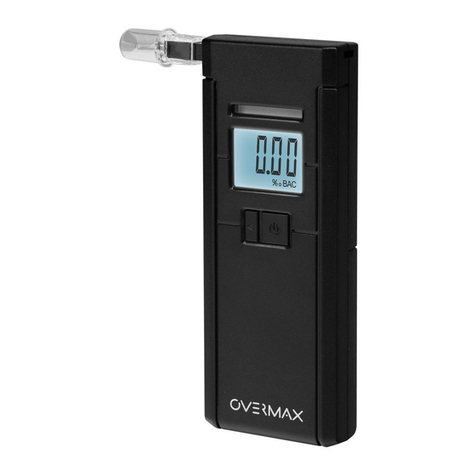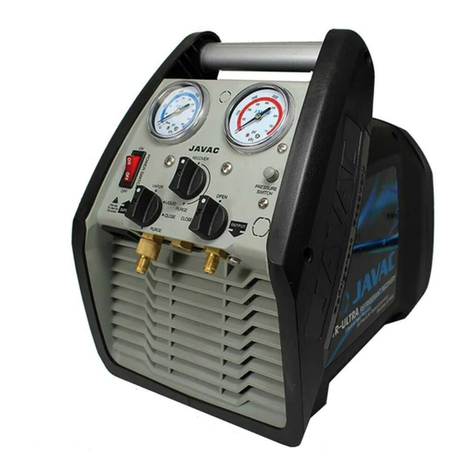Myron L ULTRAPENX2 PTBT5 User manual

PTBT5OM-X2 01-20
Operation
Manual
ULTRAPENX2™ PTBT5
Dissolved Oxygen & Temperature
Pocket Tester
For use with PTBTX2™ App
and Your iOS™ or Android™ Mobile Device

ULTRAPENX2™ PTBT5 Operation Manual
Dissolved Oxygen (DO) and Temperature Pen for use with your Mobile Device Running the PTBTX2™ App
PTBT5OM-X2 01-20
Table of Contents
INTRODUCTION ............................................................................................................ 1!
FEATURES ................................................................................................................... 1!
I.!PTBT5 - Layout ........................................................................................................ 1
II!PTBTX2 App Measurement Screen.......................................................................... 1!
III.!Feature Navigation Bar ............................................................................................ 1!
PREPARING THE DO SENSOR .................................................................................... 2!
USING THE PTBT5 ....................................................................................................... 2!
Step 1 – Download the “Ultrapen PTBTX2” App ............................................................. 2!
Step 2 – Connect the PTBT5 to the App ......................................................................... 2!
Step 3 – Choose a Measurement Parameter Setting ...................................................... 3!
Step 4 – Choose the Ultrapen Mode Setting ................................................................... 4!
Step 5 – Set the Location Altitude ................................................................................... 5!
DISSOLVED OXYGEN MEASUREMENT ...................................................................... 6!
I.!Measurement Setup ................................................................................................. 6!
II.!PTBT5 HOLD Mode Measurements ......................................................................... 6!
III.!PTBT5 LIVE Mode Measurements ........................................................................... 7!
CALIBRATION .............................................................................................................. 8!
I.!General Notes: ......................................................................................................... 8!
II.!Sensor Check .......................................................................................................... 8!
III.!Zero Calibration ....................................................................................................... 9!
IV.!Air Calibration (Water-Saturated Air) .......................................................................10!
V.!Water Calibration (Air-Saturated Water) ..................................................................11!
VI.!Temperature Controlled, Full Calibration Procedure ................................................12!
VII.!Factory Calibration Reset ........................................................................................15!
EXPORTING DATA FILES ...........................................................................................16!
MAINTENANCE............................................................................................................17!
I.!Routine Maintenance ..............................................................................................17!
II.!Storage ...................................................................................................................17!
III.!Replacing / Refilling the DO Sensor Electrolyte Solution ..........................................18!
IV.!DO Membrane Replacement ...................................................................................18!
V.!Cleaning the DO Sensor .........................................................................................19!
VI.!Replacing or Reinstalling the DO Sensor .................................................................20!
VII.!Battery Replacement...............................................................................................21!
TROUBLESHOOTING GUIDE ......................................................................................22!
SPECIFICATIONS ........................................................................................................23!
ACCESSORIES ............................................................................................................23!

ULTRAPENX2™ PTBT5 Operation Manual
Dissolved Oxygen (DO) and Temperature Pen for use with your Mobile Device Running the PTBTX2™ App
PTBT5OM-X2 01-20 1
INTRODUCTION
Thank you for purchasing the Myron L® Company ULTRAPENX2 ™ PTBT5 Dissolved Oxygen (DO) Pen. This instrument
is designed to be extremely accurate, fast, and simple to use in diverse water quality applications. Advanced features
include:
• Real time readings.
• Proprietary sensor design and microprocessor-based circuitry that measures DO with an accuracy of up to ± 2%.
• Temperature compensation algorithm that dynamically corrects for changes in membrane / sample temperature.
• Adjustment for Altitude and sample Salinity.
• Three calibration methods, AIR (Water Saturated Air), WATER (Air Saturated Water), and ZERO (0 ppm DO).
• A rugged, reliable design with an aircraft aluminum body.
• Waterproof housing.
• Replacement membranes contained in easy to install, screw-on caps.
• Enabled.
FEATURES
I. PTBT5 - LAYOUT
1. PEN BUTTON – Press to turn PTBT5 ON and place it in Standby mode.
2. BATTERY CAP – Unscrew to change battery.
3. LED INDICATOR LIGHT – Flashes rapidly when the PTBT5 is measuring and
once every 5 seconds when the PTBT5 is in Standby mode.
4. DO SENSOR BODY – Contains electrodes and reagent for
Dissolved Oxygen and Temperature measurements.
5. DO SENSOR CAP – Holds the DO sensor membrane
in place.
6. DO MEMBRANE – Permeable membrane through
which Dissolved Oxygen passes.
7. PROTECTIVE / HYDRATION CAP – Protects sensor from damage. The sensor should be kept moist at all times.
• Always replace the protective / hydration cap containing a sponge moistened with DI, RO or distilled water.
• See the MAINTENANCE section below for instructions for storing > 1 month.
• When removing or replacing the cap, gently wiggle it back and forth while pulling / pushing. DO NOT twist!
• Vent Hole: Allows air pressure to equalize during AIR calibration.
8. CAP STOP – Pushing the protective / hydration cap beyond the cap stop could damage the sensor.
II PTBTX2 APP MEASUREMENT SCREEN
1. MEASUREMENT VALUE FIELD – Displays the measured value of the solution.
When the PTBT5 turns OFF, displays the message, "Ultrapen is Offline".
2. UNITS OF MEASURE – Displays DO units of measure (ppm or %).
3. SECONDARY MESSAGE FIELD – In Default mode displays DO Saturation.
Otherwise displays the current parameter (DO Concentration or Saturation)
4. SOLUTION TEMPERATURE – Measured temperature of the solution.
5. PTBT5 BATTERY LEVEL – Flashes RED when PTBT5 battery is ≤ 25%.
6. MEMORY STORE BUTTON – Tap here to record the measurement in the App's
database.
7. MEMORY REPLACE BUTTON – Tap here to replace a previously stored
measurement with data from a new measurement.
8. MEASURE BUTTON – Tap this to start a new measurement.
9. FEATURE NAVIGATION BAR – These buttons activate various App features.
III. FEATURE NAVIGATION BAR
This bar appears at the bottom of all screens. It’s used to navigate between the App’s main functional areas.
MEASUREMENT – Returns the App to the Measurement screen.
MEMORY RECALL – Displays a list of saved measurements.
CALIBRATION – Places the App in Calibration mode.
CONNECT – Opens the App's Bluetooth Connect / Disconnect screen. Once a PTBT5 is connected to the App the button label changes
to say, “Disconnect."
PREFERENCES – Opens the App's Preferences & Settings modes, including an internet link to the full App Operation Manual (HELP).

ULTRAPENX2™ PTBT5 Operation Manual
Dissolved Oxygen (DO) and Temperature Pen for use with your Mobile Device Running the PTBTX2™ App
PTBT5OM-X2 01-20 2
PREPARING THE DO SENSOR
1. Unscrew the membrane cap from the sensor body by turning in a
counter-clockwise direction.
2. Attach the tip onto the syringe and fill the syringe with
DO electrolyte solution.
3. Rinse the inside of the membrane cap with
electrolyte solution.
4. Pour some electrolyte inside the membrane cap and set aside.
5. Hold the PTBT5 vertically with the DO sensor at the top and the
sensor opening facing up.
6. Insert the syringe tip into one of the four openings of the sensor body as far as it can go.
7. Slowly fill the electrolyte well with electrolyte.
8. Hold the electrolyte filled sensor body in one hand and bring the electrolyte filled membrane cap closer with your other
hand.
9. Tilt the membrane cap and place it onto the sensor body.
10. Carefully start turning the membrane cap clockwise until it tightens firmly to the sensor body. Some electrolyte may
escape.
11. Rinse any residual electrolyte from the outside of the sensor body with clean water (DI, RO or distilled).
12 Fill the protective / hydration cap with enough clean water to soak the sponge inside (preferably DI, RO, or distilled
water).
13. Place the protective / hydration cap onto the DO sensor all the way to the cap stop.
14. Before using the PTBT5, let the new sensor stabilize for 2-4 hours with the protective / hydration cap in place.
USING THE PTBT5
STEP 1 – DOWNLOAD THE “ULTRAPEN PTBTX2” APP
On and look for
STEP 2 – CONNECT THE PTBT5 TO THE APP
1. If the PTBT5 is OFF, press and release the PEN BUTTON to turn the PTBT5 ON and place it in Standby mode.
2. On your Device’s Home screen, tap the blue PTBTX2 icon to open the PTBTX2 App.
3. Tap the CONNECT button at the bottom of the App display.
• The App will switch to the CONNECT screen.
4. Swipe down on the screen. The
PTBT5 will appear on the list.
5. Tap the PTBT5’s name when it appears.
Default: MLC-PTBTX[Hexadecimal ID]
6. The PTBT5 will move to the top of the
list and a check mark will appear.
NOTES:
• Some Mobile Devices switch their wireless transmitters to a low power mode when their battery level gets too low.
• This could affect how easily your PTBT5 and your device connect and communicate.
• ALWAYS keep your Mobile Device charge level as high as possible. If it is <40%, plug your Mobile Device into a charger.
SYSTEM REQUIREMENTS
iOS device running iOS 10.0 or later.
If you are using an iPad,
Search for iPhone Apps.
Android device running OS 7.0 or later.

ULTRAPENX2™ PTBT5 Operation Manual
Dissolved Oxygen (DO) and Temperature Pen for use with your Mobile Device Running the PTBTX2™ App
PTBT5OM-X2 01-20 3
STEP 3 – CHOOSE A MEASUREMENT PARAMETER SETTING
The PTBT5 allows you to select one of three different ways to display DO measurements:
• DEFAULT MODE: Displays DO Concentration (ppm) and DO Saturation (%) simultaneously.
• DO CONCENTRATION: Displays DO Concentration (ppm) only.
• DO SATURATION: Displays DO Saturation (%) only.
To choose which DO Parameter to display during measurements:
1. If the PTBT5 is OFF, press and release the PEN BUTTON to turn the PTBT5 ON and place it in Standby mode.
2. Tap the PREFERENCES button in the Feature Navigation Bar.
3. Tap the line that says Ultrapen Settings.
4. Tap the Parameter Select line.
5. The App will display the current parameter
setting.
6. Tap the Parameter field.
7. Select the measurement parameter.
8. Tap APPLY. The App will update the PTBT5
parameter.

ULTRAPENX2™ PTBT5 Operation Manual
Dissolved Oxygen (DO) and Temperature Pen for use with your Mobile Device Running the PTBTX2™ App
PTBT5OM-X2 01-20 4
STEP 4 – CHOOSE THE ULTRAPEN MODE SETTING
The PTBT5 has two Ultrapen measurement modes:
• HOLD mode (Default) – The PTBT5 displays measurements in real time until the measurement has stabilized, then the App
displays the final reading and puts the PTBT5 into Standby mode.
• LIVE mode – The PTBT5 sends a series of real-time readings that are displayed continuously for up to 5 minutes after
which the final reading is held on the App’s display and the App places the PTBT5 into Standby mode. The user may end
the LIVE mode measurement series at any time prior to that by tapping the BLUE button on the App display.
To select one of these modes:
1. If the PTBT5 is OFF, press and release the PEN BUTTON to turn the PTBT5 ON and place it in Standby mode.
2. Tap the PREFERENCES button in the Feature Navigation Bar.
3. Tap the line that says Ultrapen
Settings.
4. Tap the Pen Mode line on the screen.
5. The App will display the current mode
setting.
6. Tap the Pen Mode field.
7. Select Live or Hold, then tap APPLY.
8. Return to the Measurement screen and
tap the GREEN Measure Button.
9. Either tap the BLUE button to manually
stop LIVE mode, or it will stop by itself
after 5 minutes.

ULTRAPENX2™ PTBT5 Operation Manual
Dissolved Oxygen (DO) and Temperature Pen for use with your Mobile Device Running the PTBTX2™ App
PTBT5OM-X2 01-20 5
STEP 5 – SET THE LOCATION ALTITUDE
Altitude significantly effects the amount of oxygen that can dissolve in water. As altitude increases, the amount of
dissolved oxygen decreases. BEFORE making any DO measurements it is important to adjust the Altitude setting of the
PTBT5. Altitude can be adjusted in 100 ft. increments.
1. If the PTBT5 is OFF, press and release the PEN BUTTON to turn the PTBT5 ON and place it in Standby mode.
2. Tap the PREFERENCES button in the Feature Navigation Bar.
3. Tap the Altitude line.
4. When the Altitude Adjust
screen appears, tap the
Altitude field.
5. Slide the two selection
wheels up or down to set
the altitude to the nearest
100 ft.
6. Tap Apply.
7. Tap “Settings” in the upper
left to return to the main
settings screen.
STEP 6 – SET THE SAMPLE SALINITY
Salinity also effects the amount of oxygen that can dissolve in water. As salinity increases, the amount of dissolved oxygen
decreases. BEFORE making any DO measurements it is important to adjust the Salinity setting of the PTBT5. Salinity can
be adjusted in 1 ppt increments.
1. If the PTBT5 is OFF, press and release the PEN BUTTON to turn the PTBT5 ON and place it in Standby mode.
2. Tap the PREFERENCES button in the Feature Navigation Bar.
3. Tap the Salinity line.
4. When the Salinity Adjust
screen appears, tap the
Salinity field.
5. Slide the selection wheel up
or down to set the Salinity
to the nearest 1 ppt.
6. Tap Apply.
7. Tap “Settings” in the upper
left to return to the main
settings screen.

ULTRAPENX2™ PTBT5 Operation Manual
Dissolved Oxygen (DO) and Temperature Pen for use with your Mobile Device Running the PTBTX2™ App
PTBT5OM-X2 01-20 6
DISSOLVED OXYGEN MEASUREMENT
I. MEASUREMENT SETUP
ALWAYS :
1. Makes sure that the DO sensor is filled with electrolyte and allowed to stabilize.
2. Adjust the PTBT5 Altitude to match that of the measurement location.
3. Adjust the PTBT5 Salinity to match that of the sample solution.
4. Perform at least an AIR (water-saturated air) calibration of the PTBT5.
• For best results, perform a Temperature Controlled, Full Calibration (see the CALIBRATION sections below).
• If the expected measurement is < 3 ppm, perform a ZERO calibration (see the CALIBRATION sections below).
II. PTBT5 HOLD MODE MEASUREMENTS
1. If the PTBT5 is OFF, press and release the PEN BUTTON to turn the PTBT5 ON and place it in Standby mode.
2. COMPLETELY submerge the PTBT5 sensor in the sample solution.
3. Allow the PTBT5 to equilibrate by submerging the sensor in the sample solution for 1 minute prior to making a
measurement.
4. Tap the MEASUREMENT button in the Feature Navigation Bar.
5. Tap the GREEN Measure button.
6. Swirl the pen in the sample while the
PTBT5 is measuring. The PTBT5’s
LED will flash rapidly.
• The Measure button will be
inactive.
7. When the PTBT5 completes the
measurement the App will display the
values.
• The Measure button will turn
GREEN and be active.
• MS Button
Tap to record the last measurement.
• MS Replace Button
Tap to replace data in an existing record with data from the last measurement.

ULTRAPENX2™ PTBT5 Operation Manual
Dissolved Oxygen (DO) and Temperature Pen for use with your Mobile Device Running the PTBTX2™ App
PTBT5OM-X2 01-20 7
III. PTBT5 LIVE MODE MEASUREMENTS
1. If the PTBT5 is OFF, press and release the PEN BUTTON to turn the PTBT5 ON and place it in Standby mode.
2. COMPLETELY submerge the PTBT5 sensor in the sample solution.
3. Allow the PTBT5 to equilibrate by submerging the sensor in the sample solution for 1 minute prior to making a
measurement.
4. Tap the MEASUREMENT button in the Feature Navigation Bar.
5. Tap the GREEN Measure button.
6. Swirl the pen in the sample while the
PTBT5 is measuring. The PTBT5’s LED
will flash rapidly.
7. When the PTBT5 stabilizes, it will begin
displaying measurements.
a. A flashing, BLUE, LIVE mode indictor will
appear in the upper right corner of the
Measurement field.
b. A BLUE button will appear that allows the user
to manually end LIVE mode measurements at
any time.
8. Continue swirling the Ultrapen in the
sample solution while the LIVE mode
measurement series is continuing.
9. After 5 minutes, or if the user taps the
BLUE “End Live Mode” button, the
Ultrapen will send its last measurement
result and put itself in Standby mode.
10.The App will display the final
measurement values.
MS Button: During LIVE mode, tapping the MS
button will allow you to store each new
measurement. Once you save the
measurement, the App will automatically return
to the LIVE mode Measurement screen.

ULTRAPENX2™ PTBT5 Operation Manual
Dissolved Oxygen (DO) and Temperature Pen for use with your Mobile Device Running the PTBTX2™ App
PTBT5OM-X2 01-20 8
CALIBRATION
I. GENERAL NOTES:
• It is recommended that the PTBT5 be calibrated before each series of tests.
• Verify calibration if readings are not as expected. If the expected measurement is < 3 ppm, ZERO point calibration is
particularly important.
• For greatest accuracy, see the section titled: Temperature Controlled, Full Calibration.
Accuracy After Calibration:
• ZERO Calibration + AIR Calibration @ 25°C:
o Saturation:
! 0-100%: ± 45 counts; >100%: ± 4.5% of the reading (>5°C to ≤ 55°C).
o Concentration:
! ± 0.45 ppm or ± 4.5 % of the reading, whichever is greater (up to 40˚C).
• ZERO Calibration + WATER Calibration @ 25°C:
o Saturation:
! 0-100%: ± 35 counts.
! >100%: ± 3.5% of the reading (>5°C to ≤ 55°C).
o Concentration:
! ± 0.35 ppm or ± 3.5 % of the reading, whichever is greater (up to 40˚C).
• TEMPERATURE CONTROLLED, FULL CALIBRATION @ >5°C to ≤ 55°C:
o Saturation:
! 0-100.0%: ± 20 counts; >100%: ± 2% of the reading (>5°C to ≤ 55°C).
o Concentration:
! ±0.2 ppm or ±2% of the reading, whichever is greater (up to 40˚C).
II. SENSOR CHECK
The Sensor Check is a built in feature to check the amplitude of the signal from the sensor. This is used as a troubleshooting
tool only, and is not designed to detect all sources of failure.
1. Remove the protective / hydration cap from the DO sensor.
2. Dip the sensor in clean DI, RO, or purified water.
3. CAREFULLY blot the sensor membrane with a soft, clean, lint-free cloth or tissue to remove any water drops.
4. Fill the protective / hydration cap with enough DI, RO, or distilled water to soak the sponge inside.
5. Hold the PTBT5 upright with the DO sensor down and insert the sensor into the cap. Make sure there is a good seal
between the sensor and the cap.
• DO NOT insert the sensor so far that the vent hole is covered.
6. Press and release the PEN BUTTON on the PTBT5 to turn it ON and place the PTBT5 into Standby mode.
7. Tap the CAL button in the Feature Navigation Bar.
12. The value displayed will include
temperature compensation, but
no calibration constant will have
been applied.
13. The Sensor is GOOD, if the
value displayed is ≥ 57.5%.
NOTE: If the result is <57.5%, the
sensor is not in optimal
condition. The sensor may need
to be cleaned, the membrane
cap assembly may need to be
replaced, or the entire sensor
may need to be replaced (See
MAINTENANCE section below).
14. Tap the DONE button to return
to the main calibration screen.
8. The Initial CAL screen will
appear.
9. Tap the CAL button.
10. On the Secondary CAL
screen, tap the Sensor Check
button.
11. The App will display the
raw DO Saturation value.

ULTRAPENX2™ PTBT5 Operation Manual
Dissolved Oxygen (DO) and Temperature Pen for use with your Mobile Device Running the PTBTX2™ App
PTBT5OM-X2 01-20 9
III. ZERO CALIBRATION
1. Remove the protective / hydration cap from the DO sensor.
2. Dip the sensor in clean DI, RO, or purified water.
3. CAREFULLY blot the sensor membrane with a soft, clean, lint-free cloth or tissue to remove any water drops.
4. Pour enough DO zero calibration solution (P/N DOSOL) into a beaker or cup to COMPLETELY submerge the DO
Sensor.
5. If the PTBT5 is OFF, press and release the PEN BUTTON to turn the PTBT5 ON and place it in Standby mode.
6. Submerge the PTBT5 sensor in the calibration solution.
• Allow the PTBT5 to stabilize for 1 minute prior to performing a calibration.
7. Tap the Calibration button in the Feature Navigation Bar.
8. The Initial CAL screen will appear.
9. Tap the CAL button.
10. On the Secondary CAL screen, tap the
ZERO CAL button.
11. The PTBT5 will perform the ZERO
calibration.
12. When the Calibration is done the App
displays the values and saves a CAL record.
NOTE: The AFTER CAL result should be 0.0 %.

ULTRAPENX2™ PTBT5 Operation Manual
Dissolved Oxygen (DO) and Temperature Pen for use with your Mobile Device Running the PTBTX2™ App
PTBT5OM-X2 01-20 10
IV. AIR CALIBRATION (WATER-SATURATED AIR)
1. Remove the protective / hydration cap from the DO sensor.
2. Dip the sensor in clean DI, RO, or purified water.
3. CAREFULLY blot the sensor membrane with a soft, clean, lint-free cloth or tissue to remove any water drops.
4. Fill the protective / hydration cap with enough DI, RO, or distilled water to soak the sponge inside.
5. Hold the PTBT5 upright with the DO sensor down and insert the sensor into the cap. Make sure there is a good seal
between the sensor and the cap.
• DO NOT insert the sensor so far that the vent hole is covered.
6. Press and release the PEN BUTTON to turn the PTBT5 ON and place it in Standby mode.
7. Tap the CAL button in the Feature Navigation Bar.
8. The Initial CAL screen will appear.
9. Tap the CAL button.
10. On the Secondary CAL screen, tap the
AIR CAL button.
11. The PTBT5 will perform the Air
calibration.
12. When the calibration is done the App
displays the values and saves a
calibrarion record.
NOTE: Verify the calibration by performing a Saturation measurement with the protective / hydration cap still in place.
• The result should be 104% ± 2%.

ULTRAPENX2™ PTBT5 Operation Manual
Dissolved Oxygen (DO) and Temperature Pen for use with your Mobile Device Running the PTBTX2™ App
PTBT5OM-X2 01-20 11
V. WATER CALIBRATION (AIR-SATURATED WATER)
EQUIPMENT AND SUPPLIES REQUIRED
• 1 ea. – Glass Beaker (≈1L).
• 1 ea. – Aquarium Air Pump with 1L / min capacity or better.
• 1 ea. – Aquarium Air Stone: Approximately 1.5" L x 0.49" W (3.9 cm L x 1.3 cm W).
• Aquarium Air Tubing (As required).
1. Prepare an air-saturated water solution by bubbling air
through DI, RO, or distilled water for a minimum of 30 minutes.
• Continue bubbling air through the water during the entire calibration.
2. Remove the protective / hydration cap from the DO sensor.
3. Dip the sensor in clean DI, RO, or purified water.
4 CAREFULLY blot the sensor membrane with a soft, clean,
lint-free cloth or tissue to remove any water drops.
5. Submerge the sensor in the oxygenated water but away from
the bubble stream.
6. Press and release the PEN BUTTON to turn the PTBT5 ON.
7. Tap the CAL button in the Feature Navigation Bar.
8. The Initial CAL screen will appear.
9. Tap the CAL button.
10. On the Secondary CAL screen, tap the WATER
CAL button.
11. The PTBT5 will perform the DO Water calibration.
12. When the calibration is done the App displays the
values and saves a CAL record.
NOTE: Verify the calibration by
performing a Saturation
measurement with the sensor
immersed in the oxygenated
water.
The result should be 100% ± 2%.

ULTRAPENX2™ PTBT5 Operation Manual
Dissolved Oxygen (DO) and Temperature Pen for use with your Mobile Device Running the PTBTX2™ App
PTBT5OM-X2 01-20 12
VI. TEMPERATURE CONTROLLED, FULL CALIBRATION PROCEDURE
A. GENERAL NOTES AND PREPARATION
• Both the ZERO and WATER calibration must be performed at the same temperature as the target sample solution to be
tested.
• Once you’ve calibrated the PTBT5 at a specific temperature, if the target sample solution changes temperature more than
5°C, the PTBT5 should be recalibrated at the new temperature.
• It is important to make sure that the PTBT5 sensor is completely submerged during the calibration process.
• All glassware should be clean and dry before use.
B. EQUIPMENT AND SUPPLIES REQUIRED
• 1 ea. – Hot Plate with Magnetic Stirrer: Must be capable of sustaining temperature levels to ± 1°C.
For solution temperatures below ambient, a refrigerated, circulating water bath should be used (not
shown).
• 1 ea. – Thermometer (Digital or Mercury Column). Must be accurate to at least ± 1°C, preferably ± 0.25°C
• 1 ea. – Glass Beaker (≈ 300 ml): For rinsing sensor before and after ZERO calibration.
• 1 ea. – Magnetic Stir Bar.
• 1L – Water (DI, RO, or distilled).
For ZERO Calibration
• 1 ea. – Glass Beaker (≈ 100 ml).
• 2 oz. (≈ 59 ml) – 0 ppm Dissolved Oxygen Calibration Solution (Myron L® Company P/N DOSOL).
For WATER Calibration
• 1 ea. – Glass Beaker (≈1L).
• 1 ea. – Aquarium Air Pump with 1L / min capacity or better.
• 1 ea. – Aquarium Air Stone: Approximately 1.5" L x 0.49" W (3.9 cm L x 1.3 cm W).
• Aquarium Air Tubing (As required).
TEMPERATURE CONTROLLED ZERO CALIBRATION
1. Pour the 2 oz. of ZERO calibration solution into the 100 ml
beaker.
2. Place the beaker of ZERO calibration solution onto the hot
plate.
3. Turn ON the hot plate and set it for the target temperature.
4. Let the ZERO calibration solution stabilize at the target
temperature.
• Verify the temperature of the solution using the thermometer (not
shown in diagram).
• Make sure the solution is within ± 1°C of the target temperature
before proceeding.
5. Remove the protective / hydration cap from the DO sensor.
6. Submerge the PTBT5 sensor in the rinse water and swirl for
several seconds.
7. Remove the sensor from the rinse water and carefully blot the
sensor membrane with a soft, clean cloth or tissue to remove
any water drops.
8 Completely submerge the sensor in temperature controlled
ZERO calibration solution.
9. Wait 5 minutes for the PTBT5 sensor to equilibrate.
10. If the PTBT5 is OFF, press and release the PEN BUTTON to
turn the PTBT5 ON and place it in Standby mode.

ULTRAPENX2™ PTBT5 Operation Manual
Dissolved Oxygen (DO) and Temperature Pen for use with your Mobile Device Running the PTBTX2™ App
PTBT5OM-X2 01-20 13
11. Tap the Calibration button in the Feature Navigation Bar.
12. The Initial CAL screen will appear.
13. Tap the CAL button.
14. On the Secondary CAL screen, tap the
ZERO CAL button.
15. The PTBT5 will perform the ZERO
calibration.
16. When the calibration is done the App displays
the values and saves a calibration record.
17. Remove the beaker of ZERO calibration solution from the hot plate.
18. Remove the DO sensor from the ZERO calibration solution.
19. Rinse PTBT5 in clean water (preferably DI, RO, or distilled water).
20. Fill the protective / hydration cap with enough clean water to soak the sponge inside and place it onto the DO sensor
all the way to the cap stop.
21. Allow the DO sensor to stabilize to the water-saturated air inside the protective / hydration cap for 5-10 minutes.
22. Proceed to TEMPERTURE CONTROLLED WATER CALIBRATION (Air-Saturated Water).

ULTRAPENX2™ PTBT5 Operation Manual
Dissolved Oxygen (DO) and Temperature Pen for use with your Mobile Device Running the PTBTX2™ App
PTBT5OM-X2 01-20 14
D. TEMPERATURE CONTROLLED WATER CALIBRATION
1. Pour 800 ml of DI, RO, or distilled water into the 1L beaker.
2. Place the beaker of water onto the hot plate.
3. Drop the magnetic stir bar into the beaker.
4. Place the air stone into the beaker of water.
• Make sure it is at the bottom of the beaker but will not interfere with the stir bar.
5. Turn ON the aquarium pump.
• The bubbles should be small and numerous.
• If there are only a few, large bubbles, replace the air stone with a new one.
6. Turn ON the hot plate and set it for the target temperature.
7. Turn ON the stirrer, set to approximately 500 rpm.
8. Let the air bubble through the water for at least
30 minutes.
9. Verify the temperature of the solution using the
thermometer (not shown in diagram).
• Make sure the solution is within ± 1°C of the
target temperature before proceeding.
10. Rinse the PTBT5 sensor by swirling it in the
rinse water for several seconds.
11. Carefully blot the sensor membrane with a
soft, clean, lint-free cloth or tissue to
remove any water drops.
12. Completely submerge the sensor in the aerated, temperature-controlled water (DI, RO or distilled).
• DO NOT: Let the sensor interfere with the stir bar motion.
• DO NOT: Hold the sensor directly over the air stone or in the bubble stream.
13. Wait 5 minutes for the PTBT5 sensor to equilibrate.
14. If the PTBT5 is OFF, press and release the PEN BUTTON to turn the PTBT5 ON and place it in Standby mode.
15. Tap the Calibration button in the Feature Navigation Bar.
16. The Initial CAL screen will appear.
17. Tap the CAL button.
18. On the Secondary CAL screen, tap the WATER CAL
button.

ULTRAPENX2™ PTBT5 Operation Manual
Dissolved Oxygen (DO) and Temperature Pen for use with your Mobile Device Running the PTBTX2™ App
PTBT5OM-X2 01-20 15
19. The PTBT5 will perform the WATER
calibration.
20. When the calibration is done the App displays the
values and saves a CAL record.
21. Fill the protective / hydration cap with enough clean water to soak the sponge inside and place it onto the DO sensor
all the way to the Cap Stop.
VII. FACTORY CALIBRATION RESET
The PTBT5 can be returned to factory default calibration settings using the FAC CAL function. This will erase any stored
calibration data and does NOT take the condition of the sensor or the sensor membrane into consideration.
To return your PTBT5 to factory calibration:
1. If the PTBT5 is OFF, press and release the PEN BUTTON to turn the PTBT5 ON and place it in Standby mode.
2. Tap the Calibration button in the Feature Navigation Bar.
3. The Initial CAL screen will appear.
4. Tap the FAC CAL button.
5. Tap OK to reset the PTBT5 calibration.
6. Tap CANCEL to leave it unchanged.
7. Tap the DONE button to return to the
Initial CAL screen.

ULTRAPENX2™ PTBT5 Operation Manual
Dissolved Oxygen (DO) and Temperature Pen for use with your Mobile Device Running the PTBTX2™ App
PTBT5OM-X2 01-20 16
EXPORTING DATA FILES
SELECTING AN EXPORT FORMAT:
Data records can be exported from the PTBTX2 App as either .csv, .xls or .xlsx formatted files.
1. Tap the PREFERENCES button in the Feature Navigation Bar.
2. Select App Preferences from the list that appears.
3. The main App Preferences
screen will appear.
4. Tap the Email Format line.
5. The Email Format Edit
screen will appear showing
the current setting.
6. Tap anywhere inside the
Email field.
7. A menu will appear with the
email format options.
8. Make your selection and tap
APPLY.
9. A Data Security warning
message will appear.
10. Tap OK to accept the new
Email Format.
EXPORTING DATA FILES:
1. Tap the MEMORY RECALL button in the Feature Navigation Bar.
2. Tap the EDIT button in the
top right of the screen.
3. The Record List will switch
to Edit mode.
4. If the records you want to
select do not appear on the
screen, swipe UP or DOWN
until you find them.
5. Select individual records
you wish to email by
tapping each record.
6. The DELETE and CLEAR
buttons will increment to
show the number of records
selected.
7. Tap the SELECT ALL
button to select the entire
list.
a) This selects the entire list
including records not
currently shown on the
screen.
8. Once you've selected the records, tap the SEND button in the upper left.
9. A standard email screen for your device will appear.
• The selected records will be automatically added to the email as an attachment in the chosen format.
• Add email addresses and a cover letter as you normally would when sending an email on your device type.

ULTRAPENX2™ PTBT5 Operation Manual
Dissolved Oxygen (DO) and Temperature Pen for use with your Mobile Device Running the PTBTX2™ App
PTBT5OM-X2 01-20 17
MAINTENANCE
NOTE: The PTBT5 MUST be recalibrated any time: the DO sensor is replaced; the DO membrane or the electrolyte is
replaced, or; the zinc electrode is cleaned.
I. ROUTINE MAINTENANCE
1. After each use ALWAYS rinse the DO sensor with DI, RO, or distilled water and then carefully blot the sensor
membrane with a soft, clean cloth or tissue to remove any water drops.
2. ALWAYS replace the protective / hydration cap on the DO sensor after each use.
3. Do not drop, throw, or otherwise strike the PTBT5. This voids the warranty.
4. Do not store the PTBT5 in a location where the ambient temperatures exceed its operating / storage temperature
limits.
5. DO NOT remove the DO sensor membrane except to replace it with a new membrane or to replace / refill the
electrolyte. Unnecessarily removing and replacing the same membrane can degrade the quality of the DO
measurements.
II. STORAGE
The PTBT5 sensor is continuously oxidizing and reducing even while unused, causing white zinc oxide particles to build up
inside the sensor. If you need to store the PTBT5, follow the instructions below.
Short-term storage (less than a month):
The sensor should be kept moist with the protective / hydration cap containing a sponge moistened with DI, RO or distilled
water.
Long-term storage (a month or longer):
After setup, the zinc anode will be immersed in electrolyte solution and will be continuously oxidizing, even while unused.
For long-term storage it is best to remove the electrolyte, rinse the sensor and membrane cap, and store it dry. You should
also remove the battery from the PTBT5.
To prepare the sensor for long term storage:
1. Remove the membrane cap by turning it counter-clockwise.
2. Rinse the membrane cap thoroughly with DI, RO, or distilled water, gently pat it dry with a soft lint-free cloth, and
place it to the side.
• BE CAREFUL not to harm the membrane.
3. Discard all the electrolyte solution from the sensor’s electrolyte well.
4. Fill a syringe with DI, RO, or distilled water.
5. Holding the open sensor sideways or upside down over a sink insert the syringe tip into one of the four openings of
the sensor body and thoroughly flush the electrolyte well with DI, RO or distilled water. Shake all the water out of the
sensor, and repeat 3-4 times.
6. Shake all the water from the sensor, pat dry with a soft lint-free cloth, and allow the sensor to completely dry out.
7. Remove the sponge from the protective / hydration cap.
8. Rinse the protective / hydration cap with clean water then dry it with a soft lint-free cloth.
9. Once the sensor, membrane cap, and protective / hydration cap are thoroughly dry, reinstall the membrane cap and
protective / hydration cap.
10. The foam from the protective / hydration cap should be stored separately, as any moisture in the sensor will promote
oxidation.
11. Remove the battery from the PTBT5.
12. Store the PTBT5 in a cool dry location.
• NOTE: When you are ready to use the PTBT5 after long-term storage, follow the sensor setup instructions. Verify the
membrane is not torn or otherwise damaged. If oxidation is present inside the sensor, clean the sensor prior to sensor setup
(see MAINTENANCE, Section VI).

ULTRAPENX2™ PTBT5 Operation Manual
Dissolved Oxygen (DO) and Temperature Pen for use with your Mobile Device Running the PTBTX2™ App
PTBT5OM-X2 01-20 18
III. REPLACING / REFILLING THE DO SENSOR ELECTROLYTE SOLUTION
NOTES:
• When excess bubbles have formed inside the electrolyte well, you should refill the electrolyte solution. Minimizing air
bubbles inside the electrolyte well will improve accuracy.
• Always avoid touching the membrane.
• When too many white zinc oxide particles have formed inside the electrolyte solution, or readings are not as they should
be, replace the electrolyte solution.
• If you get erroneous readings after changing the membrane cap and performing the proper calibration, completely change
the DO sensor electrolyte solution.
ELECTROLYTE REPLACEMENT PROCEDURE
1. Unscrew the membrane cap from the sensor body by turning in a counter-clockwise direction.
2. Discard all the electrolyte solution from the electrolyte well.
3. Assemble the syringe by installing the tip onto the body.
4. Fill the syringe with DO electrolyte solution.
5. Insert the syringe tip into one of the four openings of the sensor body.
6. Hold the PTBT5 vertically with the DO sensor at the top and the sensor opening facing up and fill the electrolyte well
with DO electrolyte solution.
7. Discard all the electrolyte solution from the electrolyte well. This step rinses out the electrolyte well.
8. Insert the syringe tip into one of the four openings of the sensor body as far as it can go inside the electrolyte well.
9. Hold the PTBT5 vertically with the DO sensor at the top and the sensor opening facing up and slowly fill the electrolyte
well with electrolyte. This also helps to minimize air bubbles.
• Top off with more electrolyte after removing the syringe from the sensor body.
10. Rinse the inside of the membrane cap with electrolyte solution.
11. Pour some electrolyte inside the membrane cap to minimize air bubbles that may occur during assembly.
12. Hold the electrolyte filled sensor body in one hand and bring the electrolyte filled membrane cap closer with your other
hand.
13. Tilt the membrane cap and place it onto the sensor body.
14. Carefully start turning the membrane cap clockwise until it tightens firmly to the sensor body.
• While you are screwing the membrane cap on the sensor body, some electrolyte may escape.
15. Rinse any residual electrolyte from the outside of the sensor body with clean water (preferably DI, RO or distilled
water).
16. Fill the protective / hydration cap with enough clean water to soak the sponge inside with clean water (preferably DI,
RO, or distilled water).
17. Place the protective / hydration cap onto the DO sensor all the way to the cap stop.
18. Let the new sensor stabilize for 2-4 hours with the protective / hydration cap installed before using the PTBT5 again.
IV. DO MEMBRANE REPLACEMENT
If the sensor gives erroneous readings after calibration, replace the membrane cap.
NOTES: THE FOLLOWING CONDITIONS MAY CAUSE THE DO MEMBRANE TO REQUIRE MORE FREQUENT
REPLACEMENT.
• Using the PTBT5 in extreme test conditions (e.g. high temperature) may degrade the membrane material.
• The membrane material can be clogged due to the white zinc oxide particles detaching from the zinc coil or contamination
due to oils.
• If the membrane becomes ripped, dented, punctured, or otherwise damaged, replace it immediately.
• Always avoid touching the membrane.
Other manuals for ULTRAPENX2 PTBT5
1
Table of contents
Other Myron L Test Equipment manuals

